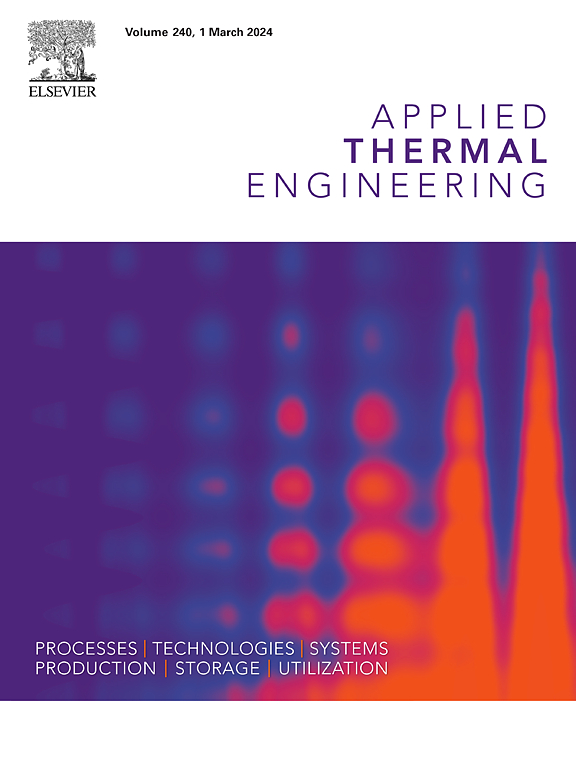热力性质法对净功率循环性能、初步部件尺寸和最大效率配置的影响研究
IF 6.1
2区 工程技术
Q2 ENERGY & FUELS
引用次数: 0
摘要
NET动力循环是一种基于全氧燃烧技术的新型超临界CO2动力循环,本文研究了热力性能方法对NET动力循环的影响。在Aspen Plus中开发了最先进的NET Power循环和空分装置配置的数值模型,以表征热力学性能,关键部件预施胶和最大效率操作配置。在以往的NET Power循环热力学研究中,传统上采用Peng-Robinson三次状态方程(EoS)作为参考状态方程(REF EoS)。然而,其较高的预测不确定性,特别是在相位建模中,可能导致不一致的结果。因此,作为一种新颖的方法,在目前的工作中,考虑了不同的EoS,如立方、病毒、SAFT和多参数亥姆霍兹自由能方法,以评估EoS对循环组件的影响,并优化循环的操作条件。REFPROP + LKP也被认为是最可靠的方法。结果表明,在额定条件下,REFPROP + LKP估计的类液相泵送阶段的流体密度比立方eos高25%。因此,压缩功降低11.57%,净循环效率提高1.48%。PC-SAFT和geg -2008模型的循环效率相对偏差较大。refeos估计再循环泵叶轮直径比REFPROP + LKP大7.49%。过大的泵将在设计点之外运行,效率低,流量控制困难,并且存在潜在的振动和超压问题。对于REFPROP + LKP,回热器所需的换热面积比REF EoS估计的低6.46%。这表明制造成本明显低于预期,瞬态响应速度快于预期。当燃烧室出口温度为1103.93℃,涡轮进出口压力分别为273.99 bar和44.83 bar,旁路分流分数为11.37%时,循环效率最高,达到55.94%。本文章由计算机程序翻译,如有差异,请以英文原文为准。

Investigation of the impact of the thermodynamic property method on the performance, preliminary component sizing and maximum efficiency configuration of the NET power cycle
This paper investigates the effect of thermodynamic property methods on the NET Power cycle, which is a novel supercritical CO2 power cycle based on the oxy-combustion technology. A numerical model of the most advanced configuration of NET Power cycle and air separation unit was developed in Aspen Plus to characterize the thermodynamic performance, key components presizing, and maximum efficiency operating configuration. The Peng-Robinson cubic Equation of State (EoS) has traditionally been adopted as the reference EoS (REF EoS) in previous thermodynamic studies on the NET Power cycle. However, its elevated predictive uncertainty, especially in phase modeling, may have led to inconsistent results. For that reason, and as a novelty, in present work, different EoS such as cubic, viral, SAFT and multiparametric Helmholtz free energy-based methods were considered, to evaluate the effect of the EoS on the cycle components and to optimize the operating conditions of the cycle. REFPROP + LKP was also included as the most reliable method. The results reveal that REFPROP + LKP estimates a fluid density in the liquid-like phase pumping stages 25 % higher than the cubic EoSs at nominal conditions. Thus, the compression work is 11.57 % lower and the net cycle efficiency 1.48 % higher. The higher relative deviations in cycle efficiency were obtained with PC-SAFT and GERG-2008 models. REF EoS estimates a recirculation pump impeller diameter 7.49 % larger than REFPROP + LKP. An oversized pump would operate outside the design point with low efficiency, flow control difficulties, and potential vibration and overpressure issues. For REFPROP + LKP, the heat exchange area required by the recuperator is 6.46 % lower than that estimated by REF EoS. This suggests that the manufacturing costs are significantly lower and transient response faster than expected. The maximum cycle efficiency resulted in 55.94 %, for a combustor outlet temperature of 1103.93 °C, turbine inlet and outlet pressures of 273.99 bar and 44.83 bar, and bypass split fraction of 11.37 %.
求助全文
通过发布文献求助,成功后即可免费获取论文全文。
去求助
来源期刊

Applied Thermal Engineering
工程技术-工程:机械
CiteScore
11.30
自引率
15.60%
发文量
1474
审稿时长
57 days
期刊介绍:
Applied Thermal Engineering disseminates novel research related to the design, development and demonstration of components, devices, equipment, technologies and systems involving thermal processes for the production, storage, utilization and conservation of energy, with a focus on engineering application.
The journal publishes high-quality and high-impact Original Research Articles, Review Articles, Short Communications and Letters to the Editor on cutting-edge innovations in research, and recent advances or issues of interest to the thermal engineering community.
 求助内容:
求助内容: 应助结果提醒方式:
应助结果提醒方式:


